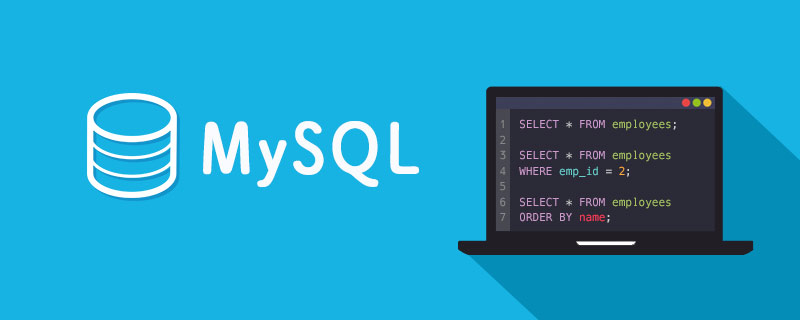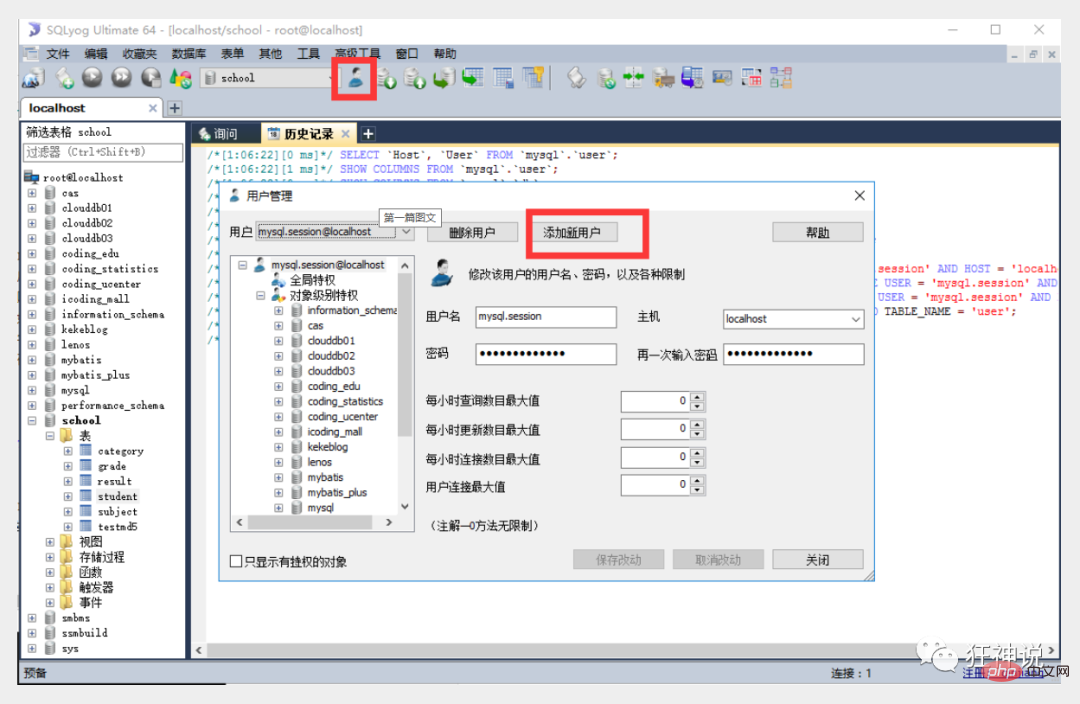How to design the database and grant permissions?
In the database, we can do many things, such as granting permissions to users, designing the database, etc. Today we will introduce how to design a database and grant permissions.

Permissions and Design Database
User Management
Use SQLyog to create users and grant permissions Demonstration

Basic commands
/* 用户和权限管理 */ ------------------
用户信息表:mysql.user
-- 刷新权限
FLUSH PRIVILEGES
-- 增加用户 CREATE USER kuangshen IDENTIFIED BY '123456'
CREATE USER 用户名 IDENTIFIED BY [PASSWORD] 密码(字符串)
- 必须拥有mysql数据库的全局CREATE USER权限,或拥有INSERT权限。
- 只能创建用户,不能赋予权限。
- 用户名,注意引号:如 'user_name'@'192.168.1.1'
- 密码也需引号,纯数字密码也要加引号
- 要在纯文本中指定密码,需忽略PASSWORD关键词。要把密码指定为由PASSWORD()函数返回的混编值,需包含关键字PASSWORD
-- 重命名用户 RENAME USER kuangshen TO kuangshen2
RENAME USER old_user TO new_user
-- 设置密码
SET PASSWORD = PASSWORD('密码') -- 为当前用户设置密码
SET PASSWORD FOR 用户名 = PASSWORD('密码') -- 为指定用户设置密码
-- 删除用户 DROP USER kuangshen2
DROP USER 用户名
-- 分配权限/添加用户
GRANT 权限列表 ON 表名 TO 用户名 [IDENTIFIED BY [PASSWORD] 'password']
- all privileges 表示所有权限
- *.* 表示所有库的所有表
- 库名.表名 表示某库下面的某表
-- 查看权限 SHOW GRANTS FOR root@localhost;
SHOW GRANTS FOR 用户名
-- 查看当前用户权限
SHOW GRANTS; 或 SHOW GRANTS FOR CURRENT_USER; 或 SHOW GRANTS FOR CURRENT_USER();
-- 撤消权限
REVOKE 权限列表 ON 表名 FROM 用户名
REVOKE ALL PRIVILEGES, GRANT OPTION FROM 用户名 -- 撤销所有权限Permission explanation
-- 权限列表
ALL [PRIVILEGES] -- 设置除GRANT OPTION之外的所有简单权限
ALTER -- 允许使用ALTER TABLE
ALTER ROUTINE -- 更改或取消已存储的子程序
CREATE -- 允许使用CREATE TABLE
CREATE ROUTINE -- 创建已存储的子程序
CREATE TEMPORARY TABLES -- 允许使用CREATE TEMPORARY TABLE
CREATE USER -- 允许使用CREATE USER, DROP USER, RENAME USER和REVOKE ALL PRIVILEGES。
CREATE VIEW -- 允许使用CREATE VIEW
DELETE -- 允许使用DELETE
DROP -- 允许使用DROP TABLE
EXECUTE -- 允许用户运行已存储的子程序
FILE -- 允许使用SELECT...INTO OUTFILE和LOAD DATA INFILE
INDEX -- 允许使用CREATE INDEX和DROP INDEX
INSERT -- 允许使用INSERT
LOCK TABLES -- 允许对您拥有SELECT权限的表使用LOCK TABLES
PROCESS -- 允许使用SHOW FULL PROCESSLIST
REFERENCES -- 未被实施
RELOAD -- 允许使用FLUSH
REPLICATION CLIENT -- 允许用户询问从属服务器或主服务器的地址
REPLICATION SLAVE -- 用于复制型从属服务器(从主服务器中读取二进制日志事件)
SELECT -- 允许使用SELECT
SHOW DATABASES -- 显示所有数据库
SHOW VIEW -- 允许使用SHOW CREATE VIEW
SHUTDOWN -- 允许使用mysqladmin shutdown
SUPER -- 允许使用CHANGE MASTER, KILL, PURGE MASTER LOGS和SET GLOBAL语句,mysqladmin debug命令;允许您连接(一次),即使已达到max_connections。
UPDATE -- 允许使用UPDATE
USAGE -- “无权限”的同义词
GRANT OPTION -- 允许授予权限
/* 表维护 */
-- 分析和存储表的关键字分布
ANALYZE [LOCAL | NO_WRITE_TO_BINLOG] TABLE 表名 ...
-- 检查一个或多个表是否有错误
CHECK TABLE tbl_name [, tbl_name] ... [option] ...
option = {QUICK | FAST | MEDIUM | EXTENDED | CHANGED}
-- 整理数据文件的碎片
OPTIMIZE [LOCAL | NO_WRITE_TO_BINLOG] TABLE tbl_name [, tbl_name] ...MySQL backup
Database backup necessity
Ensure that important data is not lost
Data transfer
MySQL database Backup method
mysqldump backup tool
Database management tools, such as SQLyog
Copy the database directly Files and related configuration files
mysqldump client
Function:
Dump database
Collect the database for backup
Transfer the data to another SQL server, not necessarily MySQL server

-- 导出 1. 导出一张表 -- mysqldump -uroot -p123456 school student >D:/a.sql mysqldump -u用户名 -p密码 库名 表名 > 文件名(D:/a.sql) 2. 导出多张表 -- mysqldump -uroot -p123456 school student result >D:/a.sql mysqldump -u用户名 -p密码 库名 表1 表2 表3 > 文件名(D:/a.sql) 3. 导出所有表 -- mysqldump -uroot -p123456 school >D:/a.sql mysqldump -u用户名 -p密码 库名 > 文件名(D:/a.sql) 4. 导出一个库 -- mysqldump -uroot -p123456 -B school >D:/a.sql mysqldump -u用户名 -p密码 -B 库名 > 文件名(D:/a.sql) 可以-w携带备份条件 -- 导入 1. 在登录mysql的情况下:-- source D:/a.sql source 备份文件 2. 在不登录的情况下 mysql -u用户名 -p密码 库名 < 备份文件
Standardized database design
Why database design is needed
When the database is more complex, we need to design the database
Poor database design:
Data redundancy, waste of storage space
Data update and insertion Exception
Poor program performance
Good database design:
Save data storage space
Can ensure data integrity
Facilitate the development of database application systems
Database design in the software project development cycle:
Requirements analysis stage: analyze the customer’s business and data processing needs
Summary design stage: Design the E-R model diagram of the database and confirm that the required information is correct and complete.
Design database steps
-
Collect information
Communicate and hold discussions with relevant personnel of the system to fully understand user needs and understand the tasks that the database needs to complete.
Identifies the entity [Entity]
Identifies the key object or entity to be managed by the database. The entity is generally a noun
Identifies the detailed information that each entity needs to store [Attribute]
Identifies the relationship between entities [Relationship]
Three major paradigms
Question: Why is data normalization needed?
Problems caused by non-standard table design:
Duplicate information
Update exception
-
Insertion exception
-
Unable to represent information correctly
-
-
Delete exception
Lost valid information
Three major paradigms
First Normal Form (1st NF)
The goal of the first normal form is Ensure the atomicity of each column. If each column is the smallest data unit that cannot be subdivided, it satisfies the first normal form
Second normal form (2nd NF)
The second normal form (2NF) is established on the basis of the first normal form (1NF), that is, to satisfy the second normal form (2NF), the first normal form (1NF) must first be satisfied.
The second normal form requires each table to describe only one thing
Third normal form (3rd NF)
If a relationship satisfies the second normal form , and other columns except the primary key are not transitively dependent on the primary key column, then the third normal form is satisfied.
The third normal form needs to ensure that each column of data in the data table is directly related to the primary key, and cannot be indirectly related. .
The relationship between normalization and performance
To meet certain business goals, database performance is more important than normalizing the database
While data is normalized, it is necessary to Comprehensive consideration of database performance
By adding additional fields to a given table to significantly reduce the time required to search for information
By inserting calculated columns into a given table , to facilitate query
Related learning recommendations:mysql tutorial(video)
The above is the detailed content of How to design the database and grant permissions?. For more information, please follow other related articles on the PHP Chinese website!

Hot AI Tools

Undresser.AI Undress
AI-powered app for creating realistic nude photos

AI Clothes Remover
Online AI tool for removing clothes from photos.

Undress AI Tool
Undress images for free

Clothoff.io
AI clothes remover

AI Hentai Generator
Generate AI Hentai for free.

Hot Article

Hot Tools

Notepad++7.3.1
Easy-to-use and free code editor

SublimeText3 Chinese version
Chinese version, very easy to use

Zend Studio 13.0.1
Powerful PHP integrated development environment

Dreamweaver CS6
Visual web development tools

SublimeText3 Mac version
God-level code editing software (SublimeText3)

Hot Topics
 1378
1378
 52
52
 How does Go language implement the addition, deletion, modification and query operations of the database?
Mar 27, 2024 pm 09:39 PM
How does Go language implement the addition, deletion, modification and query operations of the database?
Mar 27, 2024 pm 09:39 PM
Go language is an efficient, concise and easy-to-learn programming language. It is favored by developers because of its advantages in concurrent programming and network programming. In actual development, database operations are an indispensable part. This article will introduce how to use Go language to implement database addition, deletion, modification and query operations. In Go language, we usually use third-party libraries to operate databases, such as commonly used sql packages, gorm, etc. Here we take the sql package as an example to introduce how to implement the addition, deletion, modification and query operations of the database. Assume we are using a MySQL database.
 How does Hibernate implement polymorphic mapping?
Apr 17, 2024 pm 12:09 PM
How does Hibernate implement polymorphic mapping?
Apr 17, 2024 pm 12:09 PM
Hibernate polymorphic mapping can map inherited classes to the database and provides the following mapping types: joined-subclass: Create a separate table for the subclass, including all columns of the parent class. table-per-class: Create a separate table for subclasses, containing only subclass-specific columns. union-subclass: similar to joined-subclass, but the parent class table unions all subclass columns.
 iOS 18 adds a new 'Recovered' album function to retrieve lost or damaged photos
Jul 18, 2024 am 05:48 AM
iOS 18 adds a new 'Recovered' album function to retrieve lost or damaged photos
Jul 18, 2024 am 05:48 AM
Apple's latest releases of iOS18, iPadOS18 and macOS Sequoia systems have added an important feature to the Photos application, designed to help users easily recover photos and videos lost or damaged due to various reasons. The new feature introduces an album called "Recovered" in the Tools section of the Photos app that will automatically appear when a user has pictures or videos on their device that are not part of their photo library. The emergence of the "Recovered" album provides a solution for photos and videos lost due to database corruption, the camera application not saving to the photo library correctly, or a third-party application managing the photo library. Users only need a few simple steps
 An in-depth analysis of how HTML reads the database
Apr 09, 2024 pm 12:36 PM
An in-depth analysis of how HTML reads the database
Apr 09, 2024 pm 12:36 PM
HTML cannot read the database directly, but it can be achieved through JavaScript and AJAX. The steps include establishing a database connection, sending a query, processing the response, and updating the page. This article provides a practical example of using JavaScript, AJAX and PHP to read data from a MySQL database, showing how to dynamically display query results in an HTML page. This example uses XMLHttpRequest to establish a database connection, send a query and process the response, thereby filling data into page elements and realizing the function of HTML reading the database.
 Detailed tutorial on establishing a database connection using MySQLi in PHP
Jun 04, 2024 pm 01:42 PM
Detailed tutorial on establishing a database connection using MySQLi in PHP
Jun 04, 2024 pm 01:42 PM
How to use MySQLi to establish a database connection in PHP: Include MySQLi extension (require_once) Create connection function (functionconnect_to_db) Call connection function ($conn=connect_to_db()) Execute query ($result=$conn->query()) Close connection ( $conn->close())
 How to handle database connection errors in PHP
Jun 05, 2024 pm 02:16 PM
How to handle database connection errors in PHP
Jun 05, 2024 pm 02:16 PM
To handle database connection errors in PHP, you can use the following steps: Use mysqli_connect_errno() to obtain the error code. Use mysqli_connect_error() to get the error message. By capturing and logging these error messages, database connection issues can be easily identified and resolved, ensuring the smooth running of your application.
 Tips and practices for handling Chinese garbled characters in databases with PHP
Mar 27, 2024 pm 05:21 PM
Tips and practices for handling Chinese garbled characters in databases with PHP
Mar 27, 2024 pm 05:21 PM
PHP is a back-end programming language widely used in website development. It has powerful database operation functions and is often used to interact with databases such as MySQL. However, due to the complexity of Chinese character encoding, problems often arise when dealing with Chinese garbled characters in the database. This article will introduce the skills and practices of PHP in handling Chinese garbled characters in databases, including common causes of garbled characters, solutions and specific code examples. Common reasons for garbled characters are incorrect database character set settings: the correct character set needs to be selected when creating the database, such as utf8 or u
 How to connect to remote database using Golang?
Jun 01, 2024 pm 08:31 PM
How to connect to remote database using Golang?
Jun 01, 2024 pm 08:31 PM
Through the Go standard library database/sql package, you can connect to remote databases such as MySQL, PostgreSQL or SQLite: create a connection string containing database connection information. Use the sql.Open() function to open a database connection. Perform database operations such as SQL queries and insert operations. Use defer to close the database connection to release resources.




